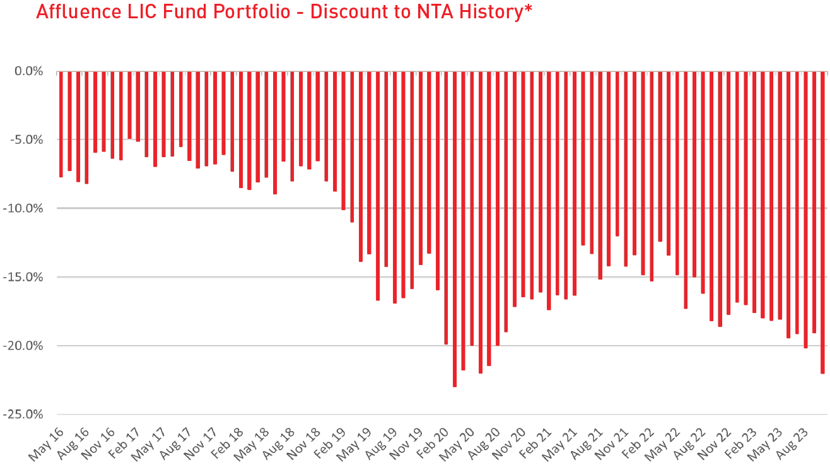Invested or interested in ASX LICs? Here are 3 to watch in 2024
Back in July, Daryl Wilson, CEO/Portfolio Manager for Affluence Funds Management, wrote that he was starting to get excited about LICs again. With average discounts across the sector hitting March 2020 lows, Wilson is putting his cash to work. He believes now could be the time to set the portfolio up for the next few years.
But are we at the bottom of the discounting?
Wilson recognises that discounting could become bigger if there is a recession, but notes that focusing on ifs and maybes is a dangerous path.
“There’s a lot of value there right now. Generally speaking, if you’re buying a LIC on average 20% cheaper than the value of its assets and the manager does a decent job, then you’re going to make reasonable money in time,” he says.
In this Rapid Fire, Wilson discusses this and the trends he is seeing across the market.
Please note that Wilson is a professional and LICs may not be the right investment choice for all investors. Management is only part of the story and Affluence Funds Management aim to ensure that the LICs they invest in are trading at the right price and the underlying assets are not overvalued. If you aren't sure, it can be valuable to speak to an expert, such as a financial adviser.
.jpg)
Firstly – a refresher. Can you explain how LICs work in terms a complete beginner could understand?
In its simplest form, a LIC (listed investment company) is a managed fund. It has an investment strategy and an investment manager like an unlisted fund or an ETF. It is listed on the stock exchange and trades like any other stock with a three-letter code.
The difference between a LIC and other funds is that the market sets the price whereas an ETF always trades based on the value of the underlying assets. A LIC might trade higher (at a premium) or lower (at a discount) based on market forces.
A LIC is also a closed fund. That means the pool of money doesn’t change and there is a set amount of shares to trade on the ASX – the assets in the fund don’t grow or shrink based on how many investors there are.
You can read more about how LICs work here.
What trends are you seeing across the LICs market that you expect to continue into 2024?
There are a few interesting things that are happening.
The first thing is that sentiment is very poor. There aren't a lot of buyers and that’s probably a result of the ongoing market correction and higher interest rates which means people are leaving money in the bank or using fixed income instead of LICs.
The LICs that have been outperforming or performing okay in the last 12 months have predominantly been the ones with higher income, like the debt-based LICs or Plato which has an equity income focus. So those funds are high in income and come with regular distributions or dividends.
Then the next thing I would say is that, because of the discounts and the poor sentiment, we’re seeing more activist investors coming into the space. There have been three or four starting to agitate for change. That is, pushing for more comprehensive solutions in LICs where performance hasn’t improved, such as transitioning to an ETF or unlisted fund or even a wind-up.
Are you seeing much discounting?
We are seeing tremendous discounting across markets. We publish the chart of the average discount for our LIC portfolio every month which we have monitored since 2016. Right now, the average discount across our LIC portfolio is 23%. The only time it’s been that high was in March 2020 – the depths of the COVID crisis.

This is as good a time for buying in terms of discounts as we’ve seen since we started.
Which LICs do you see as well positioned for 2024?
There’s quite a lot given sizeable discounts and off the back of a reasonable market correction. We’ve got over 30 LICs in our portfolio at the moment because we can figure out pretty quickly if a LIC is good value but we can’t figure out when the discount will be at its maximum or when the turnaround might happen. We’ve found the best strategy is to own quite a wide variety and then as individual investments pay off, you can lighten the load.
You can read the full details in our Melbourne Cup Guide to LICs, but here are three we like at the moment.
- Platinum Capital (ASX: PMC)
- Tribeca Global Natural Resources Limited (ASX: TGF)
- Forager Australian Share Fund (ASX: FOR)
Platinum is currently trading at a 15% discount and it’s a good time for value. We also think activist investors will help push for performance here. Tribeca is a resources-focused LIC. They’ve had a fairly chequered history but resources are very cheap on a cyclical basis. On a three-year basis, we think it’s good buying and again, you’re looking at a 15% discount. Forager is a small-caps LIC and they’ve announced that they will be converting to a managed fund in the next few months. You will get the benefits of the small-cap exposure, where we're seeing very cheap opportunities at the moment, plus you might make a bit from the transfer to the managed fund because the discount will close up.
What should investors look for and what mistakes should they avoid?
Here are a couple of things to keep in mind.
We’ve seen people get burned by not necessarily understanding what they’re going to get.
- What is the LIC investing in? What is the investment style? Is it chasing a growth mandate but you are a value investor?
- What is the track record today and consider what other products are issued by that same manager?
Also, discounting is one of the biggest things you need to understand. What is the current share price? Is it trading at a premium or a discount? How much is that discount and how does it compare to discounts in the past?
For example, there’s one LIC at the moment trading at a 10% premium to its asset value – but you could buy the unlisted fund run by the same manager at a cheaper price. It’s easy to lose 10-15% with an LIC going from a premium to a discount.
The other mistake we see is going into an LIC based on the current year's dividend yield without doing any other research. You need to understand whether that yield is sustainable and how it is being derived – can it be delivered through the cycle? You might find you have a double whammy where the dividend gets cut and the LIC falls in value because people run for the hills in that scenario.
A decade ago, LICs were the investment to watch. Now ETFs have boomed. Why do you think LICs have faltered? What would it take to change this?
When markets are challenged, LICs tend to struggle a bit. Even though there’s been recovery throughout 2023, we're still down on late 2021 values. It’s confidence-related.
The second factor is the rise of ETFs – there are a lot more options available to people to invest in. LICs are getting a smaller part of the pie because there used to be 50 ETFs and now there are over 300.
There’s also the rise of listed managed funds. The structure has evolved in the last few years, and it has become a viable alternative to an LIC. What I mean by that is the exchange traded actively managed fund where you can trade it on the ASX but it always trades at net asset value. It takes away the risk and reward of discount vs premium. We’ve seen quite a few LICs move to that structure. There are still advantages to staying in a LIC structure, one being the closed pool structure which allows more certainty over the size of the assets under management.
And a final question for fun. What’s the most interesting thing you’ve learned about one of the stocks you hold?
Here are a couple that I think have interesting portfolios.
There’s one - Hygrovest Ltd (ASX: HGV) - that owns cannabis stocks which people might not know about. It owns a few stocks producing legalised products - mostly trading in the US and Canada.
The other interesting one is the Global Masters Fund (ASX: GFL) which is 2/3 invested in Berkshire Hathaway (NASDAQ: BRK/A and NASDAQ: BRK/B). It’s one way to get access to Warren Buffett’s portfolio without having to go to the US.
3 topics
5 stocks mentioned
1 fund mentioned
1 contributor mentioned


